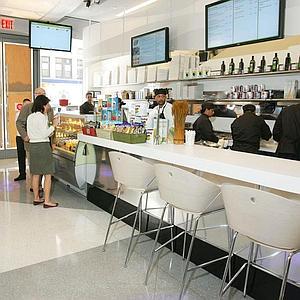STAMFORD -- Around 2008, developer Seth Weinsteinapproached the city with a plan to build housing on one of its most prominent corners: the roughly 3-acre site at Tresser and Washington boulevards that once housed The Advocate.
Adding more housing downtown had long been one of the Stamford's missions, and Weinstein was an established residential developer who said he had the funding to start construction immediately. But the plan, involving a midrise building with ground-floor retail, had a mixed reception at City Hall.
"It became clear there was a division of opinion," Weinstein said recently.
Some saw the former residential block, with its proximity to Mill River, as perfect for housing; others said the site should be reserved for commercial development. Yet another contingent complained the design was too small and boring for such a high-profile corner.
In the end, Weinstein decided not to pursue the project.
Now, after the property has remained dormant for more than a year, another developer is pitching housing.
Greenfield Partners, a Norwalk-based developer, has submitted a preliminary zoning application that calls for 350 rental apartments and 10,645 square feet of retail, commercial or live-work space.
This time, city officials appear to be on board. The difference, those involved said, is the building's unique design, along with a scaled-back economy that has all but eliminated the possibility for costly steel high-rises such as Trump Parc, and lessons from a never-realized residential downtown development known as Archstone.
Once city officials embraced housing as a use, the next challenges had to do with finding a suitable design for a site that faces two very different sections of downtown.
"It definitely wants to be a more modern building," saidNorman Cole, the city's principal planner. "Just look at what it's surrounded by: new commercial office buildings in a corridor that's mostly new construction."
But its other frontage is on Clinton Avenue, a residential block near Mill River. There, the city recognized that it had another objective: to create "an in-town kind of feel," Cole said.
On top of all that, marketplace reality required architecture to be constrained to 4 1/2-stories.
As a result, developers came up with a plan that calls for two distinctively different facades that transition from a townhouse feel on Clinton Avenue to a more "edgy and contemporary" aesthetic along Tresser and Washington boulevards, according to Richard Redniss, the project's planning consultant.
Sketches show private, street-level entrances on the ground floor on the Clinton Avenue side, and duplex apartments and terraces along the commercial corridor.
At Washington and Tresser boulevards, the building will be capped by a light beacon that is meant to give the appearance of added height and modernity, as well as enhance the night skyline in a city that has realized one gradually.
"You have many times during the day when you don't think about what a building looks like at night," Redniss said. "The whole lighting element enhances that experience."
The concept had actually first been introduced to Stamford by Archstone-Smith. Up until late 2008, the Colorado-based real estate investment trust had been involved in lengthy discussions with the Urban Redevelopment Commission over a proposed residential development on yet another prominent downtown corner: West Park Place and Washington Boulevard.
In response to the URC's request for an iconic design that would serve as a gateway into Mill River Park, Archstone came up with a tower lantern that rose a story above the building.
Last year, citing the economic downturn, Archstone gave up on the project and wound up selling the property to the city.
Kip Bergstrom, the URC's executive director, said that had it been built, the Archstone building "would have fundamentally redefined the stick product in the East."
Bergstrom said that on the West Coast, developers have been more inventive with midrise construction. The tendency here, he said, has been to construct faux colonial clapboard buildings that lack "interest, texture, urbanity."
He added, "They all tend to look like each other."
Bergstrom said preliminary plans for the former Advocate site suggest a more elegant and street-focused design that would break that east coast trend.
"I think it appeals to a huge segment of the market, which is new workers, new families," he said. "Why not create a product that's appropriate for the people that you are selling it to?"
Yet despite positive early feedback, the project is still far from certain. Because the site lies within the Mill River Corridor, the developer will have to undergo a dual review process. Its applications must be reviewed by both the city's Urban Redevelopment Commission as well as the planning and zoning boards.
Cole said the Land Use Bureau hopes to complete its assessment of the project by mid-July.
On Thursday, the URC is to begin considering the developer's request to redesignate the parcel in the Mill River Corridor Plan, as well as amend its regulations on affordable housing.
There are significant stakes for both parties. For the developer, it represents a chance to develop a prime piece of real estate. For the city, a portion of property taxes from the site, which is part of the Mill River Corridor, would go toward funding redevelopment of Mill River Park.
Redniss, who had represented Weinstein during his failed bid to develop the site, said part of the city's newfound consensus had to do with the fact that several approved residential projects fell victim to the economy and never materialized.
"The thought that we can be really picky has kind of abated," he said. "It's a combination of wanting the housing downtown and capturing that design experience."
Staff writer Elizabeth Kim can be reached at elizabeth.kim@scni.com or 203-964-2265.
 Thursday, September 23, 2010 at 12:31PM
Thursday, September 23, 2010 at 12:31PM  Ask restaurateur Jeffrey Chodorow what’s his favorite item at his new FoodParc and he’s at a loss.
Ask restaurateur Jeffrey Chodorow what’s his favorite item at his new FoodParc and he’s at a loss.